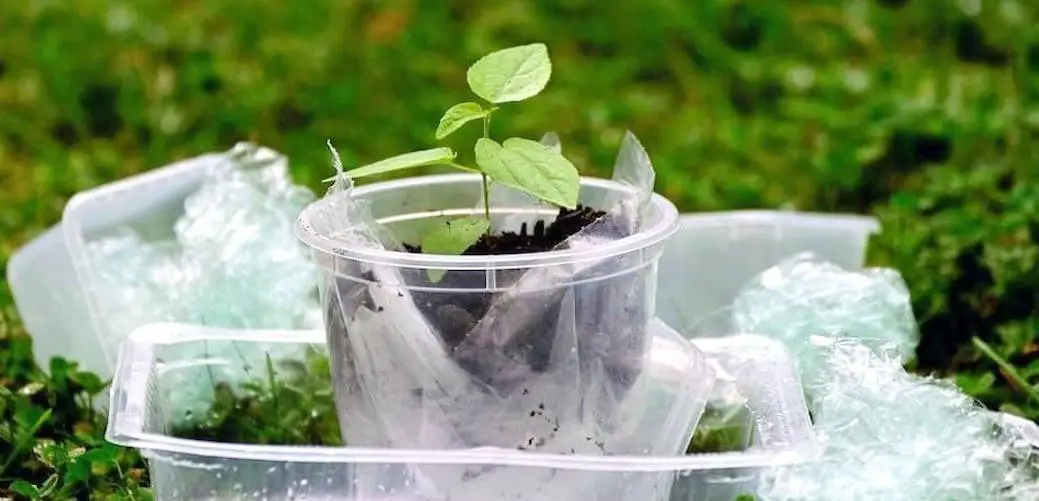These days, more and more people are becoming environmentally aware and recycling has become a very popular practice everywhere.
Whether out of responsibility towards our planet or if you just want to save some money, you are here because you’re wondering:
Can plants be recycled?
Yes, plants can be recycled, at least parts of it. In most plants, you can recycle the soil and the pot, as long as the pot is made from a recyclable material. You cannot recycle the leaves and flowers of the plant, but you can compost them.
Let’s break it all down and see which parts of a plants can actually be recycled, which composted and how to do it:
If your plant is not irreversibly dead and you just don’t want it anymore, checkout check out this article to find out if you do.
But, what if your plant is dead? How can you dispose of a dead potted plant?
You have a few options when disposing of dead potted plants, you could simply throw them away. However, it is much better if you dispose of them through composting or spreading.
Composting is the process during which organic waste decomposes naturally under oxygen and nutrients-rich conditions.
For houseplants, the organic waste consists of the leaves, stems and flowers.
The nutrients come from the soil, which contains microorganisms, whilst oxygen is provided by air and water.
How composting works:
Microorganisms from the soil eat the organic waste, which contains carbon.
This results in humus, the soil enriched with carbon and fibers, that also contains inorganic components like potassium, phosphorus and nitrogen.
With the help of oxygen, the humus is broken down through aerobic respiration, which forms the compost.
What is compost and what to do with it?
Compost is the result of the composting process. It is a mix of microorganisms and organic waste (yes, those recycled leaves of the houseplant) and it is rich in nutrients.
Compost can be used as a nutrient boost for other houseplants.

You can make your own compost pile at home, just by following the composting steps above, plus a few extra steps to speed up the process:
Compost should be kept moist to encourage microorganisms to live and multiply
Compost should be kept at high temperatures, around 68 to 86 degrees F (20 to 30 degrees C) as microorganisms thrive in high temperatures. Compost will give off heat and carbon dioxide on its own anyways so don’t overdo it with the temperature as it can get too hot and kill all the microorganisms.
Compost should be turned regularly to allow fresh air into the material and even out temperature and moist.
If you choose not to compost, the alternative to recycling houseplants is to spread it.
Spreading is the process of spreading the leaves, stems and flowers (you can include the soil too, if you want) on the lawn or over any green space, mulching them with a lawnmower, a garden fork or if you don’t have any of those, with just your gardening gloves.
There you go, this is how you can recycle houseplants, through composting or spreading.
However, if recycling by composting or spreading is not an option for you, although I highly recommend it, you can always choose to dispose of your houseplants by putting them in the Yard waste/Organic trash.
Depending on where in the world you live, this is the colour of your yard waste trash can:
| Country | Yard Waste Color |
|---|---|
| United States (not standards, but common colour) | Green |
| United Kingdom (not standards, common colour) | Brown |
| Australia (standards) | Lime Green |
| New Zealand (standards) | Dark Green |
Can Potting Soil Be Recycled?
Yes, potting soil can be recycled and reused from year to year. Even though there are some pros and cons to recycling potting soil, it can be a great way to save money on repotting expenses.
Benefits of recycling potting soil:
Saves you money
- It’s more environmentally friendly.
Drawbacks of recycling potting soil:
Recycled potting soil is usually emptied out of nutrients, so lacks anything useful that helps the houseplant live and grow.
Using recycled potted soil increases the risk of transmitting diseases from one plant to another.
But no worries, there are solutions out there.
To avoid the risk of transmitting diseases, sterilize the old soil.
To replenish lost nutrients, add a batch of compost (the one we learnt how to make earlier) and you’ll have the perfect soil to grow beautiful plants in.
8 Easy Steps to Recycle Potting Soil
Now, if I haven’t already convinced you to recycle potting soil, I’ll give it another try by telling you exactly how to do it, and you’ll see how easy it is.
Here’s how to recycle potting soil of houseplants:
1. Scoop out all the soil in the pot.
Make sure you take any remaining roots, twigs or debris out of the potting soil.
If you need a recommendation for a good scoop, here is the one I use, always go with metal.
2. Add some peat moss and perlite to the soil.
Add one part soil, two parts peat moss and perlite mix. Peat moss and perlite help with moisture retention, here is a safe choice I’ve been using.
3. Add a batch of compost to the potting soil.
This process will restore nutrients to the potting mix.
4. Mix everything together.
5. Place a layer of the new potting mix on a baking tray.
Make sure you line the tray with some aluminium foil. This will ensure you don’t ruin the tray.
6. Bake the mix in the oven.
Bake it for 30 minutes at 180-200 °F (82 – 93 °C) to eliminate any harmful bacteria from the soil.
Don’t increase the temperature as you might kill the helpful microorganisms in the mix.
7. Test the pH level of the soil.
I really recommend you use and invest in a pH meter at this step, it’s very affordable and will save you a lot of time and money in the future.
Here is a great affordable one.
It has to be around 6.8 – 7.
If it is too low, add lemon or lime juice to it. If it is too high, add some Aluminium Sulfate.
8. The new potting soil is ready to be used.
The new recycled soil is enriched with nutrients and great for your houseplants!
Can Plant Pots Be Recycled?

We know now that recycling a houseplant is not that difficult and it is beneficial for the environment and for our budget.
But what about our houseplant’s homes?
When it’s time for a pot upgrade, we are wondering what to do with the old pots.
If you’re interested in plant pots and want to get a new one, I talk about various pot materials in more detail in one of my other articles here.
So, can plant pots be recycled?
Yes, plant pots can be recycled if they are made of recyclable materials. Commonly recyclable plant pot materials are plastic, metal and peat. Pots made from ceramic, terracotta, clay and glass are non recyclable.
Here are is a more in depth recycling explanation about every plant pot material:
Ceramic or terracotta
No, ceramic or terracotta plant pots look amazing, but cannot be recycled.
Plastic
Yes, plastic pots can be recycled if the plastic is very soft and flexible and if the local recycling programs accept plasting planters. Some of them do, but most of them don’t.
Although widely recyclable, with plastic planters, the safe bet is to check with your local recycling center.
Clay
Clay pots are not generally recyclable, but sometimes yes.
For the clay pot to be recyclable, it has to be made of a high quality clay, like the one artists use to make beautiful sculptures.
Glass
No, glass plant pots cannot be recycled, although lately glass manufacturer’s have been switching to recyclable glass.
Metal
Theoretically, metal planters can be recycled.
However, chances are most curbside programs won’t accept them.
You’ll likely have to check with your local recycling center.
Peat-pots
Yes, peat is biodegradable and therefore recyclable.
If you want to dispose of peat pots, you should place them in the garden waste bin though, rather than the recycling bin.
Final Thoughts
And this is pretty much all you need to know about recycling your houseplants and their pots.
I hope that by now you have a pretty good idea of how to recycle each and every part of your houseplant.
References
EPA (United States Environmental Protection Agency) advises when it comes to composting at home – https://www.epa.gov/recycle/composting-home

